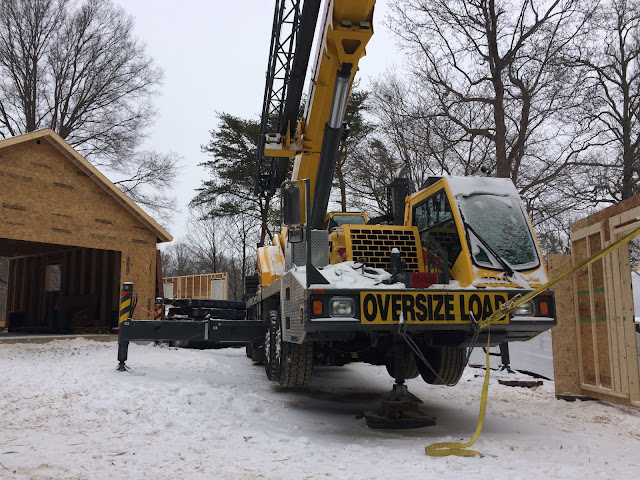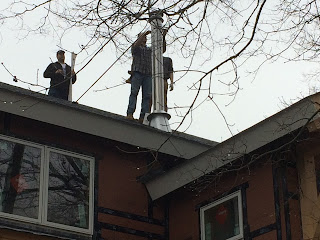BWC rented a hydraulic truck crane for the house assembly from
WO Grubb. They specified a 50 ton crane, but Grubb didn't have one available. Instead, they sent an 80 ton crane. It has five stabilizing pads, including one that's under the front of the truck. The counterweight consists of four big pieces of steel that weight 4000 or 6000 lb each. The crane looked very well maintained. We had two operators over the course of the 14 days of the crane operation, Mike and Charlie. They both were excellent.
 |
| 80 Ton Crane |
The picture may not convey the size of the vehicle. On the side of the crane is a dimension chart. We had already used the crane dimensions to locate where the center pin would go, allowing for clearance of the counterweight to swing 360 degrees. This label also has lifting and counterweight information.
 |
| Crane Dimensions |
I had done crane work in the past, but never with a boom crane, so there were some new hand signals to learn. For example, "Boom down, hold the load" instructs the operator to lower the boom (moving the load away from the crane pivot point) while taking up on the cable so that the load doesn't drop. The label shows this command as "Lower the boom and raise the load". It isn't obvious in the label that the hand signal is dynamic - hand out, thumb down, and flex the fingers in and out.
 |
| Crane Talk Hand Signals |
Charlie taught me a bit about how the controls work when we were finished with the house assembly. I was able to sit in the crane operator's seat and briefly operate the controls (not doing any actual work). Crane certification requires 2000 hours of operating time.
 |
| Crane Controls |
An electronic display shows the crane status and load. Two joysticks and three foot controls are used to drive the crane. Interestingly, the whole crane operator's cab is on a tilt mechanism so that the operator can lean the whole thing back when working high. I'm sure this reduces neck strain.
 |
| View From the Crane Operator's Seat |
Note the windshield wiper on the top of the operator's cab.
Working with the crane was one of the more interesting parts of the assembly process.







Comments
Post a Comment